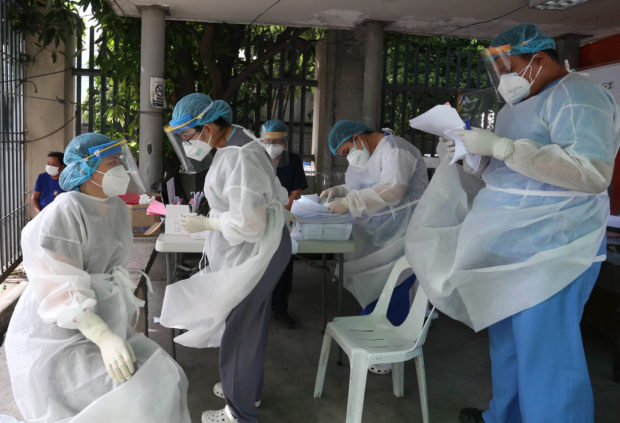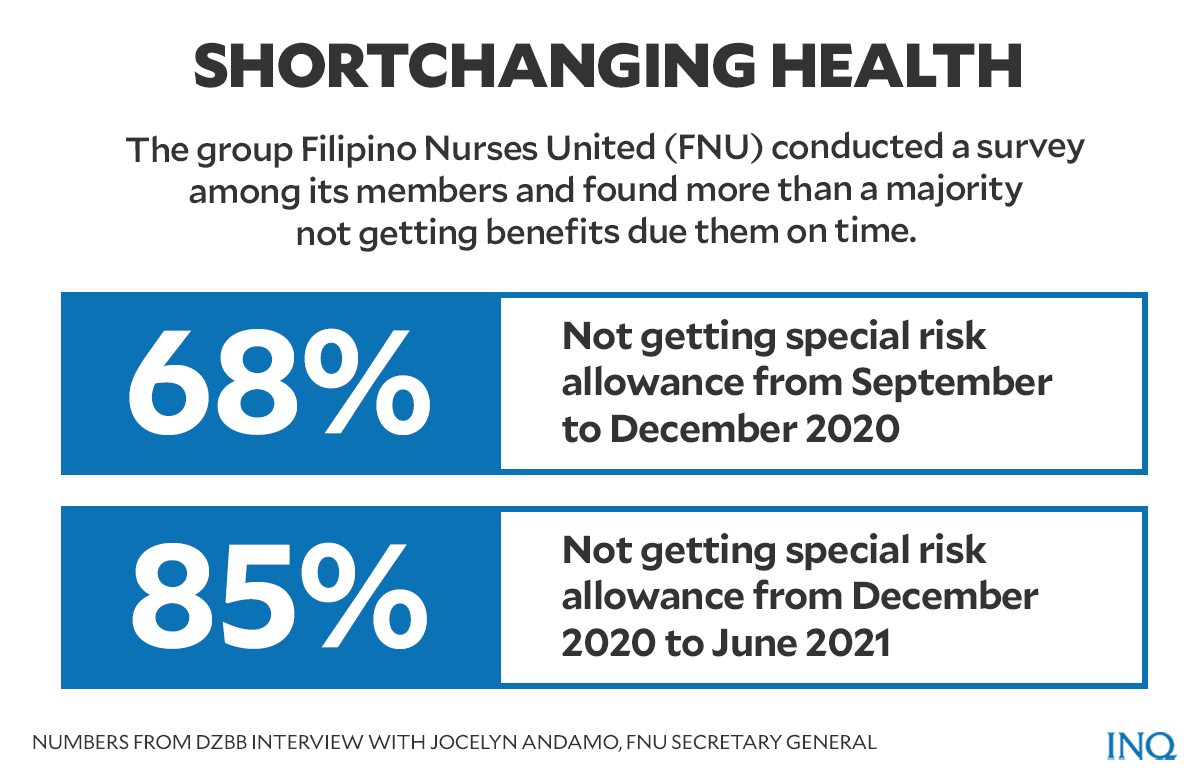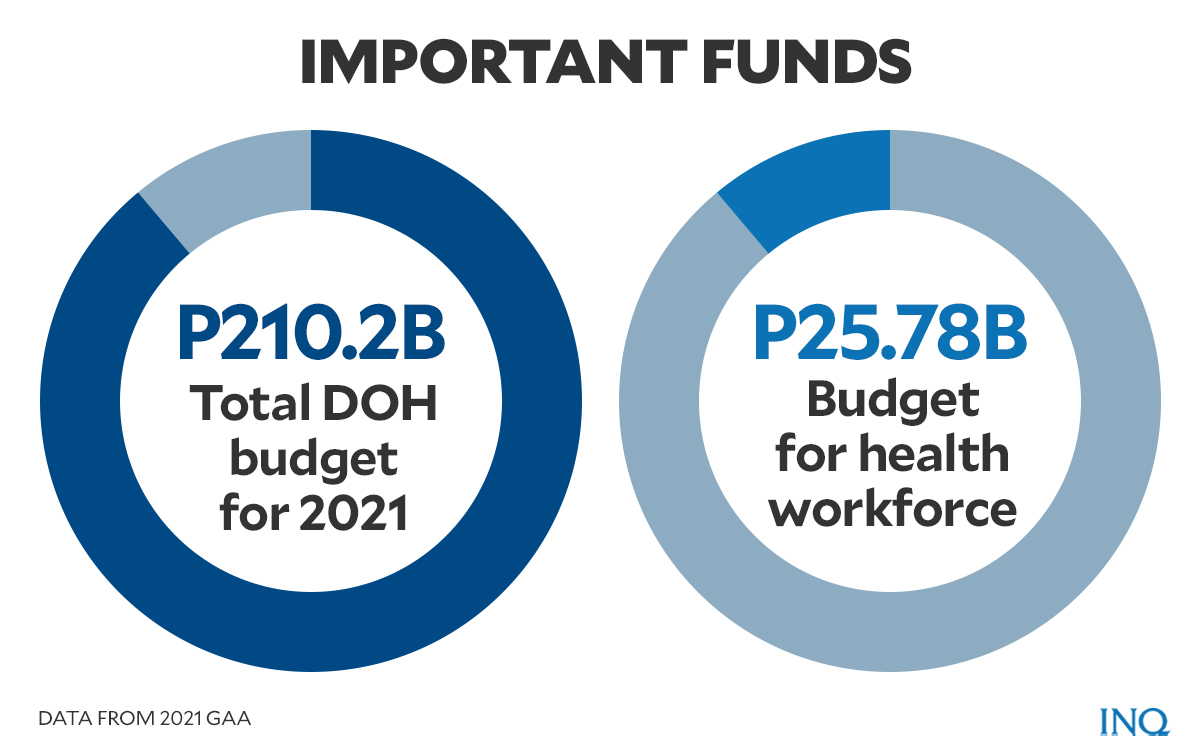2 things constant in PH COVID saga: Delayed pay, heavier burden for health care workers

STEP IN THE RIGHT DIRECTION Groups representing nurses in the public sector have commended a recent directive by Malacañang reversing a budget department circular that resulted in the “demotion” of many in their ranks. The Palace is taking off from that initiative to further accommodate back pay for the affected nurses. —INQUIRER FILE PHOTO
MANILA, Philippines—As Metro Manila reels from the return of enhanced community quarantine (ECQ) for a third time, nurses and other health care workers are being crushed under the weight of increasing COVID cases and despite getting unjust compensation.
Although the Philippines has been on quarantine for more than a year now, medical workers who are at the frontline of the fight against COVID-19 continue to echo the same complaints of being overworked but underpaid.
Unpaid benefits, delayed salaries
Jocelyn Andamo, secretary general of the group Filipino Nurses United (FNU), said many nurses belonging to her group have not yet received the benefits promised to them for their service during the pandemic — including active hazard duty pay and special risk allowance (SRA).
Andamo, speaking in Filipino in an interview with radio station DZBB, on Tuesday (Aug. 10) said her group conducted a survey among its members and found that 68 percent have not received hazard pay or SRA from September to December 2020.
At least 85 percent had not received SRA from December 2020 to June 2021, Andamo said.
The survey respondents, according to her, were from public and private health care facilities.
Last June 30, the Department of Budget and Management (DBM) released the P9.02-billion budget allotted for another tranche of SRA for health care workers.
READ: P9 billion released for health workers’ special risk allowance – DBM
The Department of Health (DOH), on the other hand, said it released the budget on the same day to its regional offices.
READ: DOH releases P9B fund for special risk allowance of healthcare workers
The allotment will cover the period Dec. 20, 2020 to June 30, 2021 as mandated by Administrative Order No. 42 issued by President Rodrigo Duterte earlier this month.
The President issued Administrative Order No. 36 in 2020, which covered the SRA for Sept. 15 to Dec. 19, 2020.
According to DBM, qualified public and private health workers can expect the payment of the SRA not later than June 30 as provided for by AO No. 42.
Under Joint Circular No. 1-2021 issued by DOH and DBM on June 16, 2021, allowances, not exceeding P5,000 a month, will be available to “public and private health workers who directly cater to or [are] in contact with COVID-19 patients.”
READ: Duterte OKs active hazard pay, special risk allowance to pandemic frontliners
“[The special risk allowance] should have already been received by health workers since the funds were released in June. Where is the money and why is it not yet distributed [to health workers]?,” said Andamo.
On Tuesday (August 10), House Resolution No. 2102 was filed by Ang Probinsyano Rep. Alfred Delos Santos seeking an investigation into the alleged “institutional and administrative impediments” which led to the delayed releases of the SRA.
READ: Probe delays in release of healthcare workers’ special risk allowance – lawmaker
The resolution noted reports of “discrepancies in the actual amounts released to different health care workers.”
This was further explained by Andamo, who said that some health workers complained after supposedly receiving only P3,000 in SRA.
“If you will compute the SRA, you will need to divide P5,000 by 22 days, which is the number of working days, then multiply it by the actual number of duty,” she said.
“So, for example, if the health worker reported for 16 or 14 days, which is the realistic numbers since nurses are required to quarantine, he or she will really not get the whole P5,000 but P3,000 for eight months’ worth of work [is very low],” she added.
Andamo also said many nurses still experience delayed and insufficient salary, including delay in release of honoraria for volunteering as medical staffers at vaccination sites.
“Two weeks ago, we received a report that nurses in NCR (National Capital Region) were not given the promised honorarium payment for their role as volunteer vaccinators,” she said.
“When they complained, the nurses eventually received the payment but it wasn’t enough and true to what was stated in their contracts,” she added.
“It is sad to see that amid the dangers of the pandemic, nurses and other health care workers feel that they are not supported,” she said.
Gov’t spending
Under the P4.5-trillion national budget for 2021 signed in 2020 by Duterte, the DOH, as the lead agency for COVID-19 response, got a P210.2-billion budget, which was 19.6 higher than its 2020 budget.
At least P25.78 billion of the DOH budget had been allocated for the Health Systems Straightening Program, which seeks to strengthen health workforce capacity.
The DOH, in its 2021 budget briefer, added that part of the budget would also be used to “support national and local health systems” through the deployment of 23,354 health workers.
The number included 744 doctors, 16,675 nurses, 4,538 midwives, 222 dentists, 303 pharmacists, 200 nutritionists, 601 med tech workers, and 81 physical therapists.
READ: PH health workers: A pandemic of big work, small pay
Overworked, higher risk
Aside from the delayed release of their salary and benefits, many nurses and health care workers—especially amid the increasing cases of the highly transmissible Delta variant—are again spending longer hours on their shifts.
“Our nurses are already exhausted. They were already very tired even before the pandemic but more especially now,” said Andamo.
“Even though DOH doesn’t call our current situation a surge, it is very clear that we have a continuous increase in COVID cases,” she added.
According to Andamo, nurses are now forced to handle more COVID-19 patients, regardless of the patients’ condition.
“Ideally, a nurse should handle three to six COVID patients. However, they now handle around 10 to 12 COVID patients. In some cases, only one nurse is assigned to patients who are intubated,” she said.
Andamo said this system can eventually compromise the quality of care for the patients.
“Our nurses hardly have time to eat. They sometimes push themselves to not go to the bathroom just to save in PPEs (personal protective equipment) which is ideally used for only four hours [but are now being used] for up to 12 hours,” she said.
Unfortunately, among the overworked health care workers, many are at high-risk exposure because they handle COVID-19 cases. These included interactions with patients directly, watchers, colleagues and others who might be infected.
In an advisory, the UP-Philippine General Hospital said interactions with persons infected with coronavirus for health care workers were highly possible and “development of COVID-19 is likely to happen in the next 14 days” after the interaction.
https://www.facebook.com/philippinegeneralhospitalofficial/photos/a.2554926417871915/4546661568698380/
As of Aug. 9, 1,327 health care workers from the UP-PGH tested positive for SARS Cov2, the virus causing COVID-19.
In a report released by the DOH, as of Aug. 9, a total of 22,032 health care workers were tested positive. It said 21,730 had recovered, 102 died and 100 remained active cases. At least 56 had no symptoms, 19 had severe symptoms, 9 were in critical condition and 10 had moderate cases.
On July 28, PGH spokesperson Dr. Jonas Del Rosario said five health care workers at the hospital, all of them fully vaccinated, tested positive for Delta variant.
READ: 21 of local Delta cases found at PGH, says official
The health care workers, according to Del Rosario, manifested mild symptoms and were not hospitalized.
Hospitals in full capacity
A few days after the government imposed ECQ in Metro Manila, many hospitals were already at critical risk in terms of their ICU capacity.
Data from DOH showed that as of Aug. 9, out of 156 hospitals in Metro Manila 30 hospitals are at critical level, 26 at high-risk, 13 are moderate, and 87 were marked safe.
DOH classifies occupancy levels for COVID-19 beds in health centers as critical, high risk, moderate, and safe.
Critical means hospitals have already reached more than 85 percent of their bed occupancy for COVID-19 patients.
Hospitals are classified as high risk if 70 percent but not more than 85 percent of COVID-19 beds are occupied, while those with a COVID-19 bed capacity of 60 to 70 percent are classified as moderate.
Hospitals fall under the safe level if their bed utilization rate is less than 60 percent.
At least 66.50 percent, or 816, of 1,227 total Intensive Care Unite (ICU) beds solely for COVID-19 patients in Metro Manila hospitals are already in use, according to the same DOH data.
The health department further reported that 58.66 percent, or 2,766, of 4,715 isolation beds, and 55.18 percent, or 2,136, of 3,871 ward beds in NCR are already occupied.
Overall, the DOH said bed occupancy rate for the whole NCR reached 58.3 percent with 5,718 out of the total 9,813 beds in use.
Several major hospitals have already declared full capacity in their COVID-19 floors, emergency room, and ICU.
READ: 12 big Metro hospitals hit ‘critical risk’ level
TSB
For more news about the novel coronavirus click here.
What you need to know about Coronavirus.
For more information on COVID-19, call the DOH Hotline: (02) 86517800 local 1149/1150.
The Inquirer Foundation supports our healthcare frontliners and is still accepting cash donations to be deposited at Banco de Oro (BDO) current account #007960018860 or donate through PayMaya using this link.

